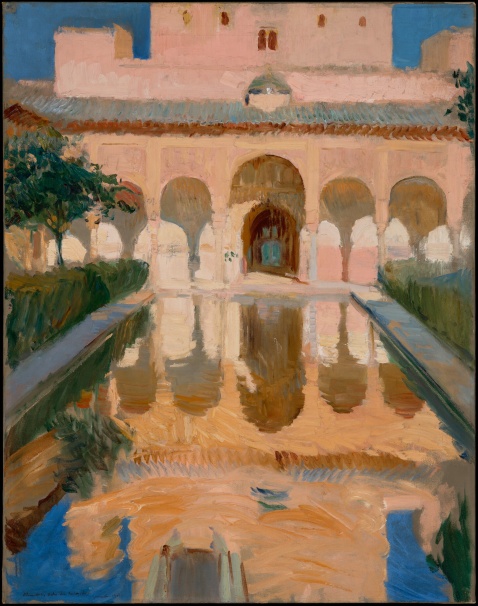
Hall of the Ambassadors by Joaquín Sorolla y Bastidaish 1909 The J. Paul Getty Museum |
|
The Alhambra - Casa Real - Courtyard of the Myrtles
Perhaps the most beautiful part of the famous Alhambra in Granada, Spain, the construction of the palaces (called Casa Real Vieja, "old Royal House or Palace") dates back to the 14th century and is the work of two great kings: Yusuf I and Muhammed V.
It is comprised of several palace groups with a series of courts and structures surrounding them which were born out of transitory or ornamental necessity. Since the 16th century these "Nasrite alcázares" (palaces) have been designated the "Casa Real Vieja" (Old Royal House) in order to distinguish them from the Christian buildings.
The Alhambra contains the three divisions usually found in a Moslem palace, including a reception salon and the royal apartments Chamber of the Lions. This spectacular chamber is the work of Muhammed V and illustrates the most beautiful possibilities of Granada Moslem art. Throughout this chamber a subtle air of femininity and daintiness is sensed, in keeping with the function of these private apartments, devoted to the placid enjoyment of home and family life.
Courtyard of the Myrtles
This courtyard is popularly known as the Patio de los Arrayanes for the fragrant shrubs growing on either side of the pond (derived from the Arabic word for myrtle).
The great pond is named for the fragrant myrtles which grew around it, in corrupted Arabic, arrayanes. The Sultan's children by his four official wives lived in the high building at the far end of the pond, on the right, although the construction of the Palace of Carlos Quinto, which looms behind it, entailed the destruction of all but the magnificent façade.
On the upper floor of the lateral walls lived the four legitimate wives of the Sultan - the Koran only allowed him four.
An alcove of the courtyard is richly decorated with plaster encrustations, and conserves some of the original colours with which the entire palace was painted.
The southern facade is composed of two levels of airy and graceful arches supported by slender columns, creating the effect of a great embroidered curtain, and was the dwelling place of the Sultan's children of at least those that he had by his four legitimate wives. And behind it lies the palace of the Christian King, like a huge granite iceberg about the crush a fragile Oriental brigantine.....
We now enter the great tower itself, called the Torre de Comares for the stained glass windows (in Arabic, comarias) which decorated its balconies, until they were blown out by the disastrous explosion of the arsenal in 1590.
Next page > Tower of Comares
Buy your copy of - Granada, City of My Dreams
 Granada, City of My Dreams: An Historical and Artistic Guide to Granada and its Moorish Palace the Alhambra
Granada, City of My Dreams: An Historical and Artistic Guide to Granada and its Moorish Palace the Alhambra
This itinerary was written for Andaluca.com by Lawrence Boheme author of “Granada, City of My Dreams”. For, what fascinates us about this universal city is not only its monuments but its marvellous story, “the encounter between Moor and Christian, gypsy and Jew, medieval and Renaissance, glistening snow and Mediterranean sun. Lawrence Bohme, poet, illustrator and curious traveller, has filled these pages with luminous descriptions and drawings, the culmination of forty years of wanderings through the palaces and labyrinths. Amazon.co.uk or Amazon.es



